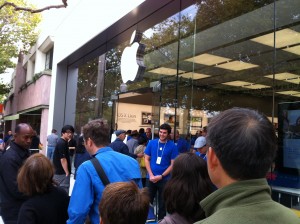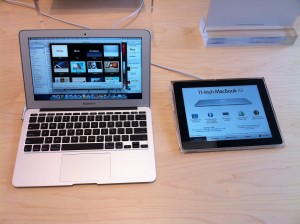This is not a recounting of all that Steve Jobs has accomplished, the ways in which he has forever altered the trajectory of our world. You can find plenty of such tributes on the web.
Today, I merely want to say thank you to Steve Jobs for the huge and enduring impact he has had on my own life.
The first computer I bought was a original Macintosh back in 1984. I never looked back. Every single computer I have owned since then has been from Apple — all the way to my current sheer delight, a MacBook Air.
I did make one brief detour back in the 1990′s and purchased a Gateway PC. It was not a replacement for my Mac, but an addition. I had agreed to write a cross-platform book and needed the Gateway to do the PC side of the book. I hated every minute of it. I sold the computer within a year and withdrew from my book contract.
In this century, my love affair with Apple products extended beyond computers to iPods and iPhones and iPads. [The Macworld Expo where Steve introduced the iPhone is still the most amazing fall-off-my-chair event I have ever attended.] Again, I never considered buying any competing device. It was Apple or nothing.
For me, like for so many others, Apple products were unlike any other purchase. I didn’t simply buy an Apple computer, I established a relationship with it. It became a member of our family. I recognized a spark in the design of Apple products that was missing from the competition, no matter how things might have stacked up on a spec sheet.
My passion for Apple products eventually blossomed into a satisfying and enriching career writing about Apple. It began with writing magazine articles and eventually extended to books and websites.
I bled six-colors, as they used to say back when the Apple logo sported a rainbow.
I say all this because I am certain that, without Steve Jobs at Apple’s helm, none of this would have happened. The products that I so admire would never have been created without Steve to oversee their development. Whatever else might have filled their place would have been far less exciting. They would never have ignited the passion that led to my career as a technology writer. The arc of the past four decades of my life has been altered by Steve Jobs more than any other person outside of my immediate family. For this, I will be forever grateful.
I didn’t agree with everything Steve did. In recent years, I have been especially critical of Steve’s positions regarding control of the App Store and jailbreaking of iOS devices. Regardless, with Steve in charge, I remained confident that the big decisions would be in the best interest of Apple and its customers. Put it this way: I’d much rather have a CEO that created an iPhone that disallows jailbreaking, than someone who would have never created the iPhone in the first place.
I am one of the lucky ones. I have been able to live the advice Steve Jobs gave at his 2005 Stanford commencement address:
“You’ve got to find what you love. And that is as true for your work as it is for your lovers. Your work is going to fill a large part of your life, and the only way to be truly satisfied is to do what you believe is great work. And the only way to do great work is to love what you do. If you haven’t found it yet, keep looking. Don’t settle. As with all matters of the heart, you’ll know when you find it.”
I found it, Steve. Thanks to you.
Steve Jobs died today. There are no words that can express the sorrow I am now feeling. The world was a better place because Steve Jobs was in it. Life goes on — as it always does. But the world will never seem quite the same again.


